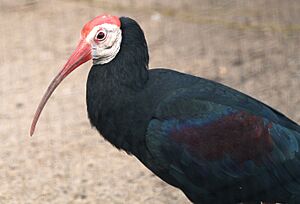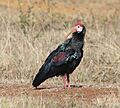Southern bald ibis facts for kids
Quick facts for kids Southern bald ibis |
|
|---|---|
 |
|
| Conservation status | |
| Scientific classification | |
| Synonyms | |
|
The southern bald ibis (Geronticus calvus) is a large bird that lives in the mountains of southern Africa. You can find it in open grasslands or dry, semi-desert areas. This bird is closely related to the waldrapp (Geronticus eremita), which lives in northern Africa. The southern bald ibis only lives in a small area, mostly in the high, mountainous parts of South Africa.
This ibis is a big bird with shiny, blue-black feathers. Its face and head have no feathers and are red. It also has a long, curved red beak. Southern bald ibises nest in groups on rocks and cliffs. They usually lay two or three eggs. These eggs hatch after about 21 days.
Southern bald ibises often gather in large groups to eat and rest. They mostly eat insects, but also small reptiles, rodents, and tiny birds. They don't make much noise, only occasional gobbling sounds. Ibises are long-legged wading birds with curved beaks. They are part of the same bird family as spoonbills. Unlike other ibises, the southern bald ibis and waldrapp have bare faces and heads. They also nest on cliffs and prefer dry places, not wetlands. This species is currently listed as vulnerable, meaning it needs protection, but it's not in immediate danger of disappearing.
Contents
Understanding the Southern Bald Ibis Family Tree
Scientists group living things into categories to understand how they are related. This is called taxonomy. The southern bald ibis was first described in 1781 by a French scientist named Georges-Louis Leclerc. Later, in 1783, another scientist, Pieter Boddaert, gave it its scientific name, Tantalus calvus. Today, it is known as Geronticus calvus.
The southern bald ibis belongs to a bird family called Threskiornithidae. This family includes birds from warm parts of the world, like ibises and spoonbills. Birds in this family often have no feathers on their faces. Ibises are a group within this family, known for their long, thin, down-curved beaks. Most ibises don't have a strong voice. They might make harsh croaking or cackling sounds. Ibises are an ancient group of birds. Fossils show they have been around for 60 million years!
The southern bald ibis is part of the Geronticus group, which has two main species. The southern bald ibis (Geronticus calvus) lives in southern Africa. Its relative, the waldrapp (Geronticus eremita), lives in northern Africa. Even though they live far apart, both species share many traits. They both nest on rocky cliffs and have adapted to finding food in dry places. Scientists believe these two species separated from each other between 335,000 and 1 million years ago.
What Does the Southern Bald Ibis Look Like?
The southern bald ibis is a unique bird found only in the highlands of southern Africa. It's not very common. In South Africa, there are only about 4,600 breeding birds of this species. We are still learning a lot about their lives.
This bird has dark green feathers that shimmer with hints of green, purple, and bronze. Its neck has long, blue-green feathers. Adult birds also have copper-colored feathers on their shoulders. Young ibises, however, are mostly dull gray. The bird's Latin name, Geronticus calvus, means "bald, old man." This name refers to its bare, wrinkled head and face. The head is the easiest way to recognize this bird because of its clear, whitish skin. On top of its head, it has a red, dome-shaped crown. Its beak and legs are red and curved downwards. Its eyes are also an orange-red color.
Where Do Southern Bald Ibises Live?
The southern bald ibis lives in a very specific area. There are only about 4,600 breeding birds in South Africa. They are found only in the eastern parts of South Africa, in high, mountainous regions. Their home range stretches from the highlands of Lesotho into Eswatini. These birds might travel short distances within their home areas.
These ibises build their nests on cliffs. They breed in open areas on mountain sides, in river gorges, and sometimes near waterfalls. Their breeding grounds are mostly mountainous grasslands, between 1,200 and 2,000 meters (about 4,000 to 6,500 feet) above sea level. These grasslands are called 'sour' because the plants have low nutritional value later in the summer and autumn, especially after animals have grazed there.
Southern Bald Ibis Behavior
The southern bald ibis often feeds and rests in large groups. They can travel in groups of up to 100 birds to find good places to eat. They are insectivores, meaning they mostly eat insects and other small creatures. They find these in burnt grasslands. These birds live on cliff edges where they build their nests. Most of them breed in colonies, but some pairs choose to nest alone. They don't make much noise, just occasional gobbling sounds.
What Sounds Do Southern Bald Ibises Make?
The southern bald ibis is generally a quiet bird. It is known to make a soft gobbling sound. This is why its old Afrikaans name was "Wilde-Kalkoen," which means "wild turkey." This bird is loudest when it's in its nesting areas or flying. It makes a high-pitched keeaaw-klaup-klaup call, which sounds a bit like a turkey.
What Do Southern Bald Ibises Eat?
This species mainly eats insects and other small creatures that live on the ground. They are foragers, meaning they search for food. They often feed in harvested corn fields, pastures where animals have grazed a lot, and burnt grasslands. They walk along the ground, pecking and poking into the soil. A big part of their diet is the caterpillar of the maize stalk borer, a type of moth. They also turn over animal droppings and leaves to find other prey. This includes caterpillars, grasshoppers, beetles, earthworms, snails, and sometimes frogs, small dead mammals, and birds.
In July and early August, before they lay eggs, these birds often look for food in corn fields. From late August to early September, while they are incubating their eggs, they switch between corn fields, grazed pastures, and burnt grasslands. Finally, in September and October, when their chicks are in the nest, they forage in corn fields, but more often in plowed fields. Ibises rarely go into tall grasses and almost never into marshy areas. They avoid tall grasses because it's hard for them to move around. It also hides their prey. They prefer to walk quickly while feeding, which is difficult in tall grass. They also seem to avoid feeding too close to their nesting sites.
Their main feeding areas, the burnt grasslands, are called “sour” because they don't have many nutrients. These areas are burned every 1 to 3 years to clear out extra plants. In winter and spring, ibises feed in these burned areas where new plants are growing. They also look for any insects they can find. Their breeding season is connected to when these areas are burned. So, their ability to breed successfully and survive partly depends on having these burnt grasslands available.
Southern Bald Ibis Reproduction and Life Cycle
The southern bald ibis builds its nests on open ledges of cliffs. Because these areas are often hard to reach, it's difficult to watch them during breeding season. However, we know that these birds mostly breed in colonies, which are large groups. Some pairs, though, choose to nest away from the main group. Females lay their eggs from late July to mid-October. After the eggs hatch, the young birds grow feathers for flying around mid-October through December.
Their nests are mostly made of sticks and grass. They usually start gathering these materials about two weeks before the first egg is laid. Once the first egg is laid, it takes about 26 to 32 days for it to hatch. The parent birds turn the egg more often about three days before it hatches. After hatching, the chicks are fed by their parents for the first 7 to 10 days. The parents bring up food from their stomachs for the chicks. After about 35 days, the young birds start to leave the nest and explore nearby. After 40 to 50 days, the chicks can fly. However, they still spend most of their time on the cliff ledges or in their nest.
Protecting the Southern Bald Ibis
The southern bald ibis is currently listed as vulnerable on the IUCN Red List of Threatened Species. This means it needs protection, but it's not in immediate danger of extinction. The bird is also listed by CITES (Convention on International Trade in Endangered Species). This means that trading this species is carefully controlled.
One of the biggest reasons for the decline of this species is human activity at their breeding sites. Their homes are also being damaged. Most breeding sites are on private land. Only a small number of breeding pairs are found in nature reserves or state forests, where they are guaranteed protection. This means that a large part of the ibis population depends on the efforts of private landowners. Another threat is that adult birds might be caught. Their eggs and nestlings are sometimes collected for food or traditional medicine in some African tribal practices. Hunting these birds has also been common among farming communities to add to their meat supply. Local hunting is still a threat today.
Images for kids







